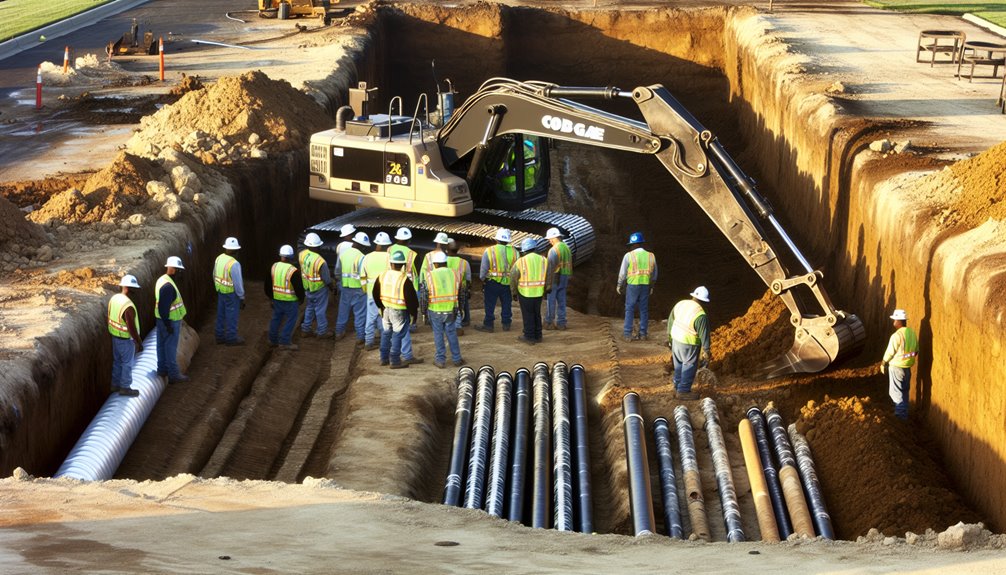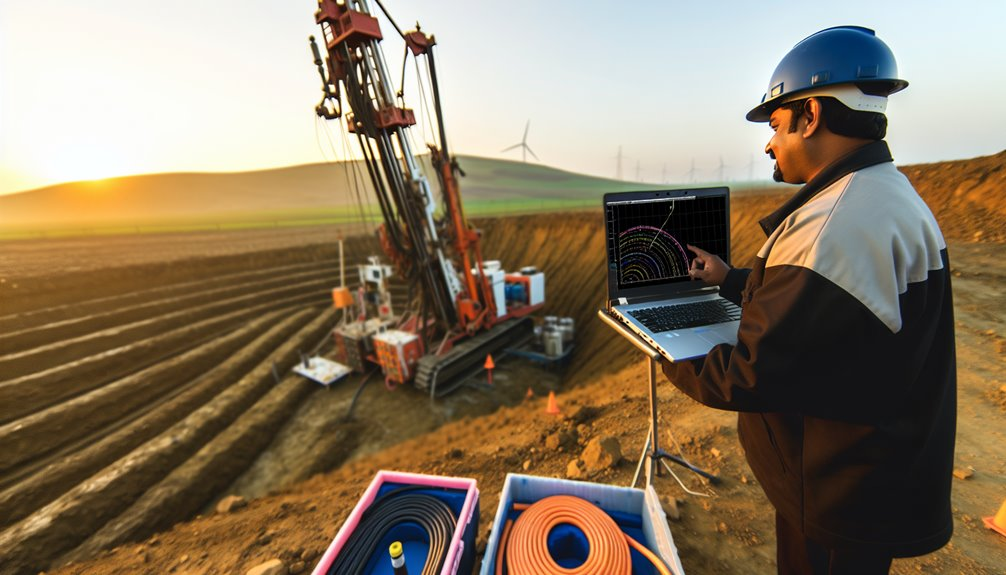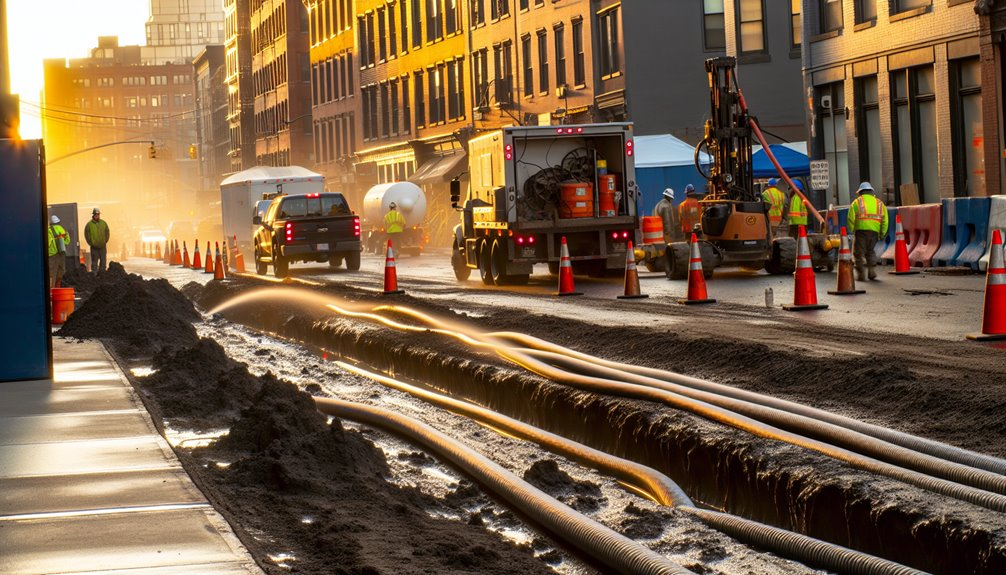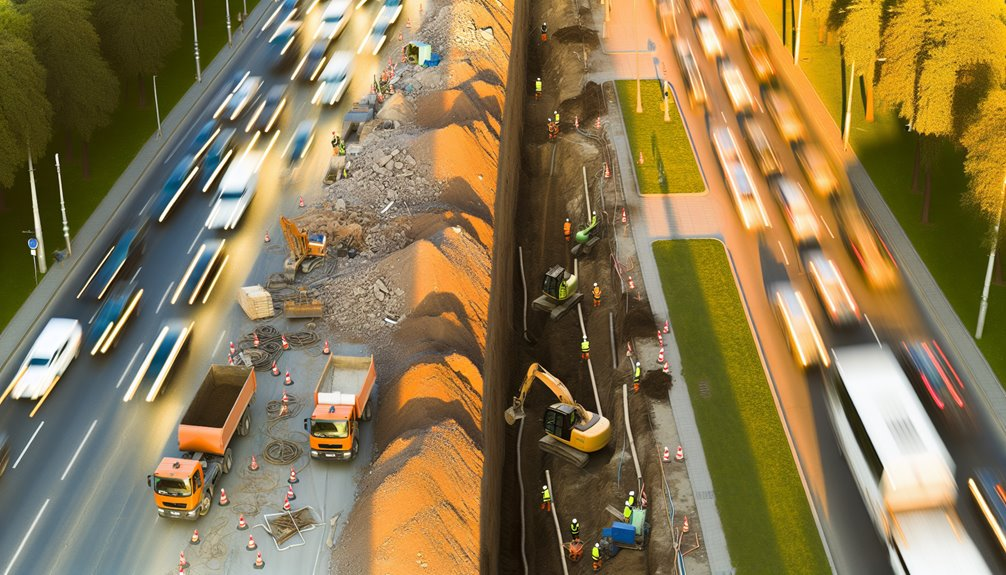When you initiate a trenching project, selecting the right technique is essential. Modern trenchless methods, such as directional drilling or microtunneling, offer you precision with minimal surface disruption. You'll need to weigh the benefits of these advanced technologies against traditional excavation, considering factors like soil type and project scale. As you plan, don't overlook the importance of rigorous safety protocols to protect your team and the public. What could happen if safety isn't prioritized? Let's explore the potential risks and how to mitigate them.
Understanding the Scope of Modern Trenching Techniques
To grasp the full extent of modern trenching techniques, it's essential to understand the variety and capabilities of the methods currently employed in the field.
Conventional trenching uses heavy machinery like excavators, ideal for large-scale projects requiring depth and speed. However, this method can be disruptive to the environment.
On the other hand, trenchless techniques, such as Horizontal Directional Drilling, Microtrenching, and Pipe Bursting, offer less invasive alternatives. These methods utilize advanced trenching materials and technologies to minimize surface disruption while efficiently installing or upgrading underground utilities. Each method requires specific materials and planning, tailored to the project's scale, the terrain's nature, and the surrounding infrastructure's sensitivity. Trenchless methods are particularly beneficial as they preserve vegetation, reducing the environmental impact compared to conventional trenching.
The Role of Advanced Equipment in Enhancing Trenching Efficiency
As you explore the role of advanced equipment in trenching, consider how cutting-edge machinery, such as chain and rock trenchers equipped with conveyor systems, boosts your project's efficiency by handling tough terrains and automating material transport. Precision control systems in these machines, featuring GPS and laser-guidance, allow you to execute trenching with exacting accuracy, minimizing deviations from planned excavation paths. Additionally, the automation within trenching operations not only streamlines processes but also greatly reduces your labor costs and project timelines, ensuring you meet tight deadlines with ease. This machinery's ability to adjust to different soil conditions enhances overall operator-friendly experience and productivity, optimizing job performance across varying environments.
Cutting-Edge Trenching Machinery
In the domain of trenching services, cutting-edge machinery such as the Tesmec 1675 Evo and the 1475 XL Evo plays a vital role in elevating operational efficiency.
The Tesmec 1675 Evo, equipped with a 7060 horsepower engine, allows for deep and wide trenching, supporting excavation techniques that tackle up to 24 feet deep and 72 inches wide trenches.
Meanwhile, the 1475 XL Evo's 630 horsepower engine is tailored for precision trenching of large diameter pipelines, even in challenging conditions.
These machines feature advanced gearboxes and flywheels, enhancing chain pull and reducing wear, essential for maintaining the integrity of trenching equipment.
Such robust engine power guarantees not only swift digging but also minimizes downtime, driving efficiency in your projects.
Precision Control Systems
Leveraging precision control systems greatly enhances the efficiency of trenching operations. By integrating GPS surveying and laser-guided equipment, you markedly reduce errors and improve the precision of excavation.
This tech not only guarantees accurate trench depth and alignment but also facilitates consistent trench quality, essential for varying soil conditions. Real-time data capabilities of these systems allow for immediate trench monitoring and adjustments, optimizing the digging process and minimizing human error.
With machine control systems, you automate grading, achieving precise placement and smooth trench walls—critical for protecting installed utilities. This approach not only speeds up project completion but also boosts safety by preempting potential hazards, ultimately enhancing productivity and reducing costs.
Automation in Trenching Operations
Building upon precision control systems, advanced automation technologies now further amplify the efficiency of trenching operations.
You'll experience cutting-edge automated excavation that elevates trenching efficiency through several key features:
- Automatic Machine Guidance: Utilize GNSS technology for precise digging alignment, depth, and grade.
- Auto Steering and Control: Full automatic operation minimizes manual adjustments, streamlining processes.
- Pre-set Working Parameters: Set and forget functionality allows autonomous execution of complex tasks.
- Anti-Collision Functions: Enhanced safety with alerts for underground utilities or obstacles.
- Real-Time Data Recording: Create as-built maps documenting exact utility locations on the go.
These innovations guarantee you're at the forefront of productive and safe trenching operations, maximizing both time and resource efficiency.
Safety Protocols for Trenching Operations
You must implement extensive protective measures to prevent trench collapses, incorporating systems such as sloping, shoring, and shielding, especially in trenches over five feet deep.
Your emergency response planning should include detailed procedures and training for rapid and effective incident handling.
Ensuring these protocols are in place not only enhances safety but also complies with OSHA standards, safeguarding your operations against potential legal and financial repercussions.
Implementing Protective Measures
Before beginning any trenching operations, it's crucial to conduct thorough site assessments to identify and mitigate potential hazards.
You'll need to meticulously evaluate soil stability, identify underground utilities, and develop a detailed safety plan.
Here are key steps to implement protective measures:
- Utilize appropriate protective systems such as shoring or trench shields based on soil type and trench depth.
- Document and communicate all findings and safety plans to every crew member.
- Regularly inspect protective installations to guarantee their integrity and effectiveness.
- Conduct daily hazard assessments to adapt to changing conditions and maintain safety.
- Train your team thoroughly in hazard recognition, the use of protective systems, and emergency response protocols.
Staying ahead with these strategies promotes a safer trenching operation.
Trench Collapse Prevention
Having established the significance of implementing protective measures in trenching operations, it's vital to focus specifically on preventing trench collapses.
First, you'll assign a competent person tasked with overseeing the entire operation, making certain they're trained to recognize excavation hazards and enforce trench safety protocols.
Prior to excavation, calling 811 to mark underground utilities is key to avoid unintended disruptions.
Additionally, evaluating the soil's stability helps in selecting the right protective systems such as sloping, shoring, or trench shields, reducing the risk of a collapse.
Implementing these systems, particularly in trenches deeper than 20 feet, requires designs from registered professional engineers to guarantee compliance and safety.
Daily inspections will further mitigate risks, keeping the site safe for all workers involved.
Emergency Response Planning
To guarantee the safety of all personnel during trenching operations, it's crucial to develop an extensive Emergency Response Plan (ERP).
Here's what you need to integrate:
- Clear Procedures: Establish straightforward protocols for a range of emergencies, ensuring everyone knows their roles.
- Communication Protocols: Enhance response communication using advanced, reliable tech solutions to alert and coordinate with teams instantly.
- Rescue Equipment: Confirm all necessary rescue equipment is readily available and maintained.
- Training in Rescue Operations: Continually train your crew, focusing on swift and effective responses.
- Regular Emergency Drills: Conduct these drills to rehearse the ERP, enhancing the preparedness and confidence of your team in real crisis situations.
Planning and Preparing for Trenching Projects
When planning a trenching project, it's important to conduct a thorough site survey to evaluate the terrain, soil composition, and any potential obstacles or hazards.
You'll need to map out underground utilities to prevent damage and accidents, determining the trench's depth and width based on your specific requirements. It's vital to create a detailed plan that outlines the trench route, dimensions, and necessary safety protocols.
Efficient trenching project timelines hinge on meticulous planning and smart trenching resource allocation.
Make certain you have all required permits and approvals before breaking ground. Selecting the appropriate equipment and maintaining it in prime condition minimizes downtime and enhances productivity.
Each step should align with stringent safety standards and regulatory compliance to safeguard your team and project integrity.
The Impact of Soil Types on Trenching Strategies

Understanding the classification and stability of soil types is essential in determining the most effective trenching strategies. The implications of soil type effects on trench design adaptations are significant and require technical precision to guarantee safety and efficiency.
Here are key considerations:
- Type A Soils: Allow for vertical trench walls, but watch for tension cracks that may develop over time.
- Type B Soils: Require careful monitoring for surface cracking and potential water seepage, impacting wall stability.
- Type C Soils: Necessitate continuous support due to their loose consistency and sensitivity to vibrations.
- Stable Rock: Offers high stability, reducing the need for extensive shoring systems.
- Overall Strategy: Adapt trench designs based on soil stability, from straight trenches in stable soils to sloped or benched approaches in less stable conditions.
Innovations in Trenching Technology
As the trenching industry evolves, technological innovations are dramatically enhancing the efficiency and safety of operations.
You'll find that automated excavation systems like TrenchSense by Vermeer and Ditch Witch's Anti-Stall Technology streamline the process by automating reactions to obstructions, reducing downtime.
The introduction of Built Robotics' Exosystem transforms standard excavators into autonomous machines, enabling precise, GPS-guided trenching without manual oversight.
This leap in trenching technology not only boosts productivity but also greatly mitigates human error and enhances safety on site.
Furthermore, real-time data from systems like the Trench Depth Meter and synthesized sensor data guarantee that every cut is exact, optimizing both the performance and the longevity of your trenching equipment.
Cost Management in Trenching Services
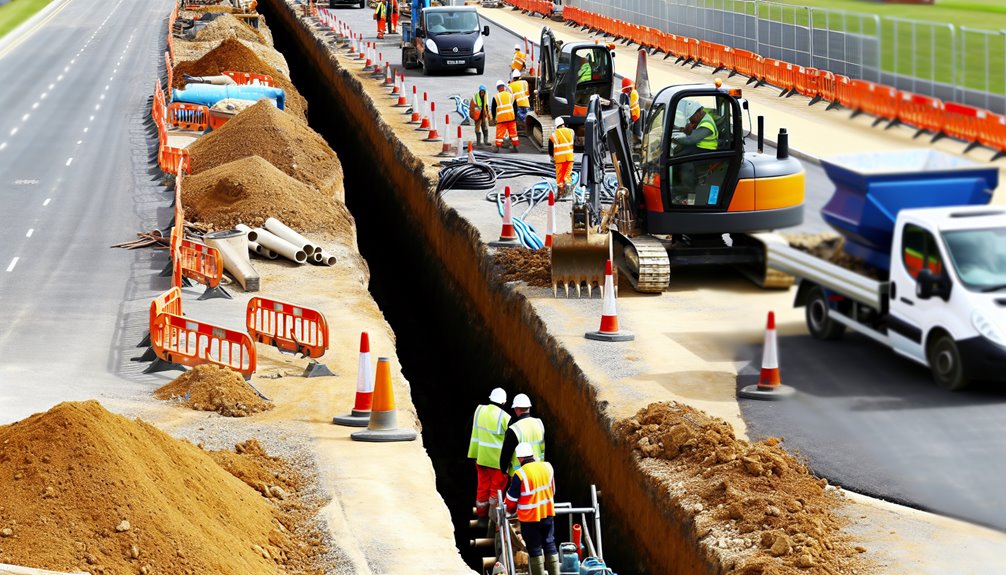
Managing costs effectively is essential in trenching services, as expenses can vary considerably based on several key factors.
You'll need to focus on thorough cost analysis and meticulous budget planning to guarantee financial efficiency.
Here's how you can optimize your trenching budget:
- Depth and Length Analysis: Deeper and longer trenches escalate costs due to increased labor and materials.
- Soil Assessment: Identify soil type early to anticipate challenges and adjust the budget for potential obstacles.
- Equipment Efficiency: Invest in high-efficiency machinery to reduce operational costs over time.
- Safety Investments: Include costs for necessary safety measures which, while initially higher, reduce potential future liabilities.
- Permit and Ancillary Costs: Always factor in varying permit expenses and potential obstruction removal costs to prevent budget overruns.
Case Studies: Successful Trenching Projects and Lessons Learned
After exploring the complexities of cost management in trenching services, let's examine real-world applications through various case studies that highlight successful projects and the lessons they offer.
In one project, meticulous planning incorporated GPS and laser-guided equipment, aligning with trenching best practices for precision. This approach not only streamlined the workflow but also minimized disruptions caused by unforeseen soil conditions.
Another example demonstrated the importance of regular equipment inspections, which greatly reduced downtime. Adhering strictly to safety protocols, including thorough training and the use of Personal Protective Equipment (PPE), considerably mitigated risks, showcasing effective project management.
Each case underlines the critical nature of preparation, the right tool selection, and stringent safety measures in achieving operational excellence in trenching services.
Conclusion
As you commence trenching projects, it's essential to leverage cutting-edge techniques and equipment. Confirm you conduct detailed planning and soil assessments to tailor your approach, enhancing both safety and efficiency. Embrace innovations and adhere to strict safety protocols to mitigate risks. By doing so, you'll not only meet but potentially exceed industry standards, leading to cost-effective and successful outcomes. Remember, thorough preparation and strategic implementation are key to maneuvering the complexities of modern trenching.
If you're looking to dive deeper into trenching services or have any questions, I invite you to visit Boring Bros at boringbro.com. You can also give us a call at (954) 639-6167. We're here to help you navigate your projects with ease and expertise!

